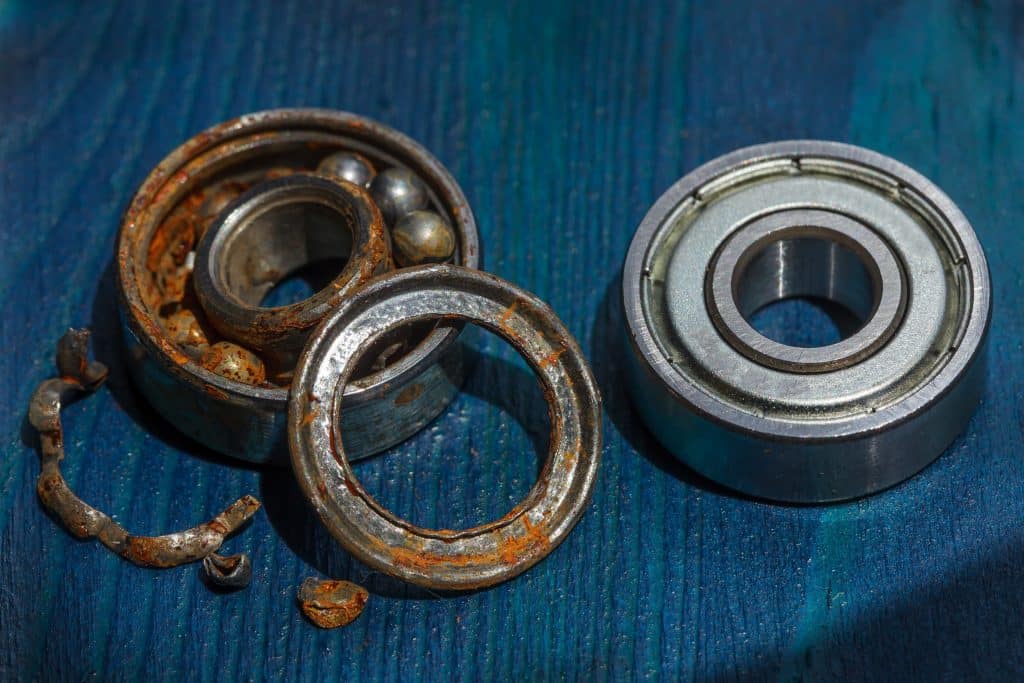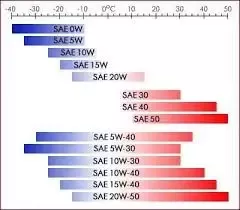Grease uneven distribution in bearings can cause increased friction, noise, and overheating. This leads to premature wear and potential bearing failure.
Bearings play a crucial role in reducing friction between moving parts. Proper lubrication is essential for their optimal performance. Uneven grease distribution can significantly impact the efficiency and lifespan of bearings. Symptoms include unusual noises, increased operating temperatures, and higher friction levels.
Regular maintenance and correct lubrication techniques are vital to avoid these issues. Ensuring even grease distribution helps in maintaining smooth operation, preventing costly downtime and repairs. Understanding these symptoms allows for timely intervention and enhances the reliability of machinery. Proper care and attention to lubrication practices ensure the longevity and performance of bearings.
Introduction To Bearing Grease Distribution
Bearings need grease to run smoothly. Proper grease distribution is vital. It ensures the bearing works efficiently. Uneven grease distribution can cause many problems. Understanding this is important for bearing health.
The Role Of Grease In Bearings
Grease reduces friction in bearings. It helps in smooth movement. It also protects against wear and tear. Grease acts as a barrier. It keeps dirt and moisture out. This increases the life of the bearing.
Choosing the right grease is essential. Different bearings need different types of grease. The right amount of grease is also crucial. Too much or too little can cause problems. Regular checks ensure proper grease levels.
Consequences Of Uneven Grease Distribution
Uneven grease distribution can lead to serious issues. It can cause parts to wear out quickly. Friction increases when grease is not spread evenly. This generates more heat.
High temperatures can damage the bearing. It can also lead to bearing failure. Uneven grease can also cause noise. Bearings may squeak or make grinding sounds. This indicates a problem.
| Consequence | Description |
|---|---|
| Increased Friction | Parts wear out faster due to more friction. |
| Heat Generation | Uneven grease causes higher temperatures. |
| Noise | Bearings make squeaking or grinding sounds. |
| Bearing Failure | Improper grease distribution can lead to failure. |

Credit: cbeuptime.com
Identifying Symptoms Of Uneven Grease Distribution
Uneven grease distribution in bearings can lead to various issues. Identifying these symptoms early can prevent further damage. Below are common signs of uneven grease distribution.
Unusual Noises From Bearings
Unusual noises are often the first sign of uneven grease distribution. You may hear grinding or squeaking sounds. These noises occur because parts rub together without proper lubrication.
Listen closely to your machinery. If you hear unusual sounds, inspect the bearings immediately. Quick action can save you from costly repairs.
Excessive Vibration And Heat Generation
Excessive vibration is another common symptom. Bearings should operate smoothly. If they don’t, you might feel vibrations. This usually means there’s uneven grease distribution.
Heat generation is a critical sign as well. Bearings should not be hot. If they are, it means too much friction is occurring. This is due to poor lubrication.
| Symptom | Description |
|---|---|
| Unusual Noises | Grinding or squeaking sounds from bearings. |
| Excessive Vibration | Noticeable vibrations during operation. |
| Heat Generation | Bearings becoming hot to touch. |
Monitoring these symptoms helps maintain your machinery. Regular checks ensure bearings are well-lubricated and running smoothly.
Visual Inspection Clues
Visual inspection of bearings can reveal many issues. These issues include grease uneven distribution. Knowing what to look for can help prevent bigger problems. Here are some clues to watch for.
Grease Leakage Signs
Grease leakage is a common sign of uneven distribution. Look around the bearing housing. You might see grease escaping. This can indicate over-greasing or poor sealing.
Check for grease on adjacent machinery. Grease should stay within the bearing. Grease outside the bearing means something is wrong.
- Grease on machinery
- Grease on the floor
- Excess grease near seals
Discoloration And Contamination
Discoloration of the grease can signal a problem. Clean grease is usually a specific color. If the grease looks different, it might be contaminated.
Check for dirt and debris. Clean grease should not have particles. Contaminated grease can harm the bearing. Discolored grease can also mean overheating.
| Normal Grease Color | Problematic Grease Color |
|---|---|
| Light brown | Dark brown or black |
| Green | Gray or metallic |
Regular checks can catch these issues early. Look for these visual clues. They can save you time and money.

Credit: www.mdpi.com
Monitoring Bearing Performance
Monitoring bearing performance is essential for identifying issues early. Uneven grease distribution in bearings can cause serious problems. Knowing the symptoms helps in maintaining the equipment. This section covers two important methods for monitoring bearing performance.
Using Vibration Analysis Tools
Vibration analysis tools are crucial for detecting grease issues in bearings. These tools measure the vibration levels of the bearing. High vibration levels indicate uneven grease distribution. Early detection can prevent severe damage.
Here’s a simple table to understand the vibration levels:
| Vibration Level | Condition |
|---|---|
| Low | Normal |
| Medium | Possible Issue |
| High | Serious Problem |
Regular monitoring with vibration tools is essential. It helps to spot problems before they become costly repairs.
Thermal Imaging For Heat Anomalies
Thermal imaging is another effective method. This tool detects heat anomalies in the bearing. Uneven grease distribution causes the bearing to overheat. High temperatures indicate a problem.
Follow these steps to use thermal imaging:
- Point the thermal camera at the bearing.
- Check the temperature reading.
- Compare it with the normal operating temperature.
If the bearing is hotter than usual, it may have uneven grease. Timely action can save the equipment from failure.
Using these methods ensures bearings run smoothly. Proper monitoring leads to longer equipment life and fewer breakdowns.
Preventive Measures
Preventing grease uneven distribution in bearings is crucial for machinery efficiency. Implementing proper measures helps avoid costly repairs and downtime. Below are essential steps to ensure even grease distribution.
Proper Grease Selection
Choosing the right grease is vital. Use grease compatible with your bearing type and operating conditions. Consider the following factors:
- Temperature Range: Ensure the grease works well at operating temperatures.
- Load Capacity: Select grease that can handle the bearing load.
- Speed Rating: Match the grease with the bearing’s speed requirements.
- Water Resistance: Choose water-resistant grease for wet environments.
Regular Maintenance Schedules
Establishing a regular maintenance schedule helps in catching uneven grease distribution early. Follow these steps:
- Inspection: Regularly inspect bearings for signs of uneven grease.
- Re-lubrication: Apply fresh grease at recommended intervals.
- Cleaning: Clean bearings before applying new grease.
- Monitoring: Use sensors to monitor bearing conditions.
| Maintenance Task | Frequency | Notes |
|---|---|---|
| Inspection | Monthly | Check for uneven grease and wear. |
| Re-lubrication | Quarterly | Use manufacturer-recommended grease. |
| Cleaning | Annually | Remove old grease before applying new. |
| Monitoring | Continuously | Use temperature and vibration sensors. |
Ensuring proper grease selection and adhering to regular maintenance schedules significantly reduces the risk of uneven grease distribution in bearings.
Greasing Techniques For Even Distribution
Proper greasing ensures bearings work smoothly. Uneven grease distribution can cause damage. Learn the best techniques for even grease distribution in bearings.
The Right Amount: How Much Is Too Much?
Applying the right amount of grease is essential. Too much grease can cause overheating. Too little grease leads to wear and tear.
Here’s a simple guide:
| Bearing Size | Grease Amount |
|---|---|
| Small | 1-2 grams |
| Medium | 2-4 grams |
| Large | 4-8 grams |
Best Practices For Applying Grease
Follow these steps for even grease distribution:
- Clean the bearing thoroughly.
- Use a grease gun for precise application.
- Apply grease slowly to avoid air pockets.
- Rotate the bearing during application.
- Check for even coverage after application.
Remember to use the right type of grease. Use high-quality grease designed for bearings.
Troubleshooting Common Greasing Mistakes
Greasing bearings correctly is critical for their longevity and performance. Improper greasing can lead to several issues, including uneven grease distribution. This section will explore the common mistakes made during greasing and how to troubleshoot them.
Overgreasing And Its Impacts
Overgreasing is a common mistake that can harm bearings. When too much grease is applied, it can cause excessive heat build-up. This heat can lead to the breakdown of the grease and cause the bearing to fail. Overgreasing can also increase pressure, forcing the grease out of the bearing.
- High Operating Temperature: Excess grease causes friction, raising the temperature.
- Seal Damage: Excessive grease can break seals, leading to contamination.
- Increased Wear: The bearing experiences increased wear due to grease being forced out.
Undergreasing And Its Risks
Undergreasing is another common issue that can cause bearing failure. When too little grease is applied, the bearing is not adequately lubricated. This lack of lubrication can cause metal-to-metal contact, leading to wear and tear. Undergreasing can also allow contaminants to enter the bearing, causing further damage.
- Increased Friction: Insufficient grease increases friction, leading to higher wear.
- Contamination Risk: Lack of grease allows contaminants to enter the bearing.
- Shortened Bearing Life: The bearing’s life is reduced due to inadequate lubrication.
Understanding these common greasing mistakes is essential. Proper greasing ensures the longevity and performance of your bearings.
Case Studies: Learning From Real-world Examples
Understanding grease uneven distribution in bearings is crucial. Real-world examples help us learn and improve. This section explores success stories and failures. We aim to understand better practices and solutions.
Success Stories Of Correcting Uneven Grease Distribution
Several companies have tackled this issue successfully. Here are some case studies:
- Company A: They noticed uneven wear in their machinery. The issue was traced back to grease distribution. They implemented an automated lubrication system. This system ensured even grease distribution. Downtime reduced by 20% and machinery lifespan increased.
- Company B: A leading manufacturer faced frequent bearing failures. They initiated a thorough investigation. The root cause was uneven grease distribution. They trained their maintenance team and introduced regular checks. Bearing failure rate dropped by 30%.
- Company C: They had issues with high operational noise. Engineers discovered uneven grease distribution. They switched to a high-quality grease and adjusted application techniques. Noise levels decreased significantly. Customer satisfaction improved.
Analyzing Failures To Improve Future Practices
Learning from failures is equally important. Here are a few examples:
- Case Study 1: A company faced repeated bearing seizures. Investigations showed improper grease application. Maintenance schedules were irregular. The company revised their protocols. Regular inspections were mandated.
- Case Study 2: Another firm experienced unexpected machinery breakdowns. The root cause was identified as uneven grease distribution. They lacked proper training for maintenance staff. They implemented a comprehensive training program. This reduced breakdowns significantly.
- Case Study 3: A plant had issues with high energy consumption. Engineers found that grease was not reaching all parts of the bearing. They upgraded their lubrication system. Energy consumption dropped, and efficiency improved.
| Company | Issue | Solution | Result |
|---|---|---|---|
| Company A | Uneven wear | Automated lubrication system | 20% downtime reduction |
| Company B | Bearing failures | Maintenance team training | 30% failure rate drop |
| Company C | Operational noise | High-quality grease | Improved customer satisfaction |
| Case Study 1 | Bearing seizures | Revised maintenance protocols | Regular inspections |
| Case Study 2 | Machinery breakdowns | Training program | Reduced breakdowns |
| Case Study 3 | High energy consumption | Upgraded lubrication system | Improved efficiency |
Conclusion: Maintaining Bearing Health
Maintaining the health of your bearings is crucial for optimal machine performance. Uneven grease distribution can lead to serious issues. Address these symptoms quickly to prevent costly repairs and downtime. Here, we summarize the key points and emphasize the importance of ongoing learning in bearing maintenance.
Key Takeaways For Optimal Bearing Operation
- Regular Inspection: Check bearings frequently for signs of uneven grease distribution.
- Proper Lubrication: Use the correct type and amount of grease.
- Temperature Monitoring: Keep an eye on bearing temperatures for any spikes.
- Vibration Analysis: Conduct regular vibration tests to detect early signs of wear.
- Cleaning: Ensure bearings are clean and free from contaminants.
Continual Learning And Adaptation In Bearing Maintenance
Bearings are integral to machine operations. Continually update your knowledge about bearing maintenance. Adapt to new technologies and methods. This proactive approach can save time and money.
Training programs and workshops are available. They provide valuable insights into new maintenance techniques. Join industry forums and read relevant publications. These resources offer real-world tips and solutions.
Stay informed about the latest advancements in bearing technology. This helps ensure efficient and effective maintenance routines. Your commitment to learning will directly impact the longevity and performance of your bearings.
Keep these key takeaways in mind. Regular inspection and proper lubrication are essential. Stay updated on new methods and technologies. Your bearings will thank you.

Credit: www.bearing-news.com
Frequently Asked Questions
What Happens If You Over Grease A Bearing?
Over-greasing a bearing can cause overheating, leakage, and seal damage. This reduces bearing life and efficiency.
What Is One Of The First Signs Of Bearing Failure?
One of the first signs of bearing failure is unusual noise, such as grinding or squealing sounds.
What Would Be The Effect Of Lack Of Lubrication On Bearing?
Lack of lubrication causes bearing wear, overheating, and increased friction. This leads to premature failure and higher maintenance costs. Regular lubrication ensures optimal performance and longevity.
What Does Excessive Grease Filling Of A Bearing Result In?
Excessive grease filling of a bearing can lead to overheating, increased friction, and reduced bearing life. It may also cause leakage and contamination, resulting in equipment failure. Proper grease levels ensure optimal performance and longevity.
Conclusion
Recognizing the symptoms of uneven grease distribution in bearings is crucial. Proper maintenance can prevent costly repairs. Regular inspections ensure optimal bearing performance and longevity. Addressing lubrication issues promptly helps maintain machinery efficiency. Stay vigilant and proactive in monitoring your bearings to avoid potential failures and extend equipment life.


